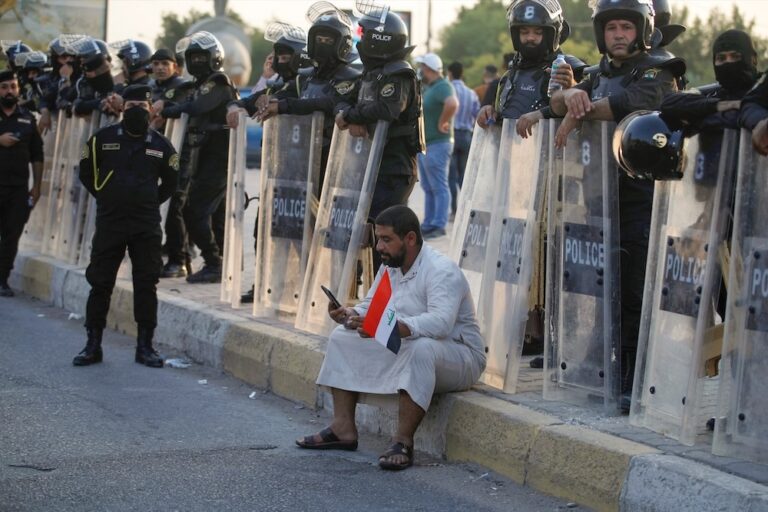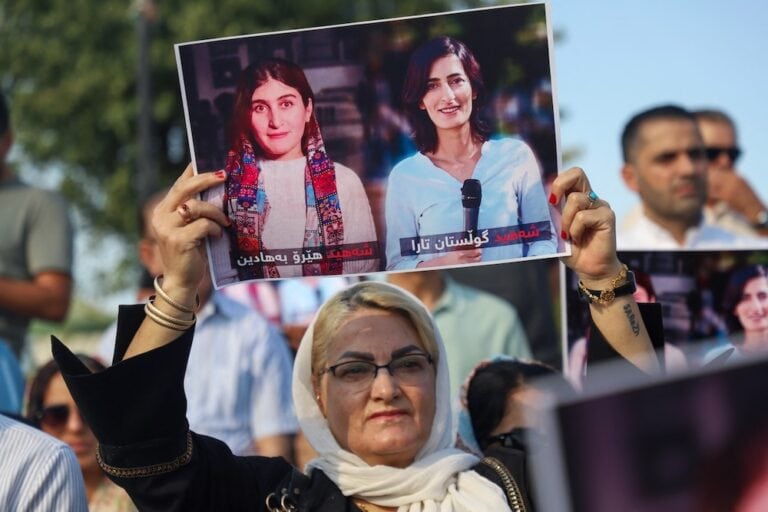(CPJ/IFEX) – The following is a 17 March 2006 CPJ press release: In Iraq, murder top cause of journalist deaths Local journalists increasingly targeted, CPJ finds New York, March 17, 2006 – Murder has overtaken crossfire and other acts of war as the leading cause of work-related deaths among journalists and media support workers in […]
(CPJ/IFEX) – The following is a 17 March 2006 CPJ press release:
In Iraq, murder top cause of journalist deaths
Local journalists increasingly targeted, CPJ finds
New York, March 17, 2006 – Murder has overtaken crossfire and other acts of war as the leading cause of work-related deaths among journalists and media support workers in Iraq, and local journalists are far and away the most vulnerable to attack, a new analysis by the Committee to Protect Journalists has found. CPJ research, compiled for the third anniversary of the conflict, shows that 67 journalists and 24 media support workers have been killed since the war began on March 20, 2003, making it the deadliest conflict for the press in recent history.
In the past 10 days alone, suspected insurgents have murdered three Iraqi journalists and one media worker: Muhsin Khudhair, editor of the news magazine Alef Ba; Amjad Hameed, head of programming for Iraq’s national television channel Al-Iraqiya, and his driver Anwar Turki; and Munsuf Abdallah al-Khaldi, a presenter for Baghdad TV.
The killings offer a chilling snapshot into recent trends. Iraqis constitute nearly 80 percent of journalists and support staffers killed for their work in Iraq, CPJ research shows. Overall, 60 percent of the journalists and support workers killed in Iraq were targeted for assassination. The third year of the war brought a significant shift in the danger, CPJ research shows, after two years in which crossfire had been a more frequent cause of media deaths.
Insurgent actions are behind most of the deaths since the war began. More than two-thirds of journalist and support worker deaths stemmed from murders, suicide bombings, and acts of war committed by insurgents, CPJ research shows.
“As we look back on three dangerous years for journalists in Iraq, we see violent trends escalating and reinforcing the dangers reporters are facing,” CPJ Executive Director Ann Cooper said. “Today, we mourn the loss of our colleagues. It is imperative that the neutrality of the press be respected, and that journalists be able to cover this conflict safely without being targeted so that free information about Iraq can reach the outside world.”
Here are other findings in CPJ’s analysis:
– The conflict is the deadliest in CPJ’s 25-year history, surpassing the 58 journalists killed in the Algerian conflict from 1993 to 1996.
– The Iraq Media Network, which receives funding from the U.S. government and includes national broadcaster Al-Iraqiya, has suffered the greatest losses, with nine journalists and six support workers killed. The Dubai-based satellite news channel Al-Arabiya has had six journalists and five support workers killed.
– Baghdad province has been the most dangerous for the press, with 33 journalists and 15 media workers killed, along with 23 journalists kidnapped. Nineveh province, which includes Mosul, has been the site of 11 journalist and three support worker deaths, along with five kidnappings.
– Thirty-nine journalists have been kidnapped since the war began. European journalists have been targeted most frequently, with 18 having been seized. Seven of those kidnapped were Americans, including freelance reporter Jill Carroll who was abducted at gunpoint on January 7. She has not been released. Iraqi journalists Marwan Ghazal and Reem Zaeed, abducted on February 1, have also not been released.
Below are detailed statistics compiled by CPJ. Note that data on journalists and media support staffers are presented separately below.
JOURNALISTS KILLED ON DUTY: 67*
Here is a statistical analysis of journalists killed in Iraq since hostilities began in March 2003, as compiled by the Committee to Protect Journalists. CPJ considers a journalist to be killed on duty if the person died as a result of a hostile action – such as reprisal for his or her work, or crossfire while carrying out a dangerous assignment. CPJ does not include journalists killed in accidents, such as car or plane crashes, unless the crash was caused by aggressive human action (for example, if a plane were shot down or a car crashed trying to avoid gunfire). Nor does CPJ include journalists who died of health ailments.
* In addition, CPJ keeps a separate tally of media support workers who have been killed. That number stands at 24. A detailed breakdown of media worker deaths is presented separately.
By Year:
– 2006: 7
– 2005: 22
– 2004: 24
– 2003: 14
By Nationality:
– Iraqi: 48
– European: 9
– Other Arab countries: 3
– United States: 2
– All other countries: 5
By Gender:
– Men: 61
– Women: 6
By Circumstance:
– Murder: 34
– Crossfire or other acts of war: 33
Responsibility:
– Insurgent action: 42 (Includes crossfire, suicide bombings, and murders.)
– U.S. fire: 14 (CPJ has not found evidence to conclude that U.S. troops targeted journalists in these cases. While the cases are classified as crossfire, CPJ continues to investigate.)
– Iraqi armed forces, during U.S. invasion: 3 (All are crossfire or acts of war.)
– Source unconfirmed: 8
By Job:
– Photojournalists: 21 (Includes still photographers and camera operators.)
– Reporters and editors: 35
– Producers: 7
– Technicians: 4
By Location:
– Anbar province (Fallujah, Ramadi): 4
– Nineveh province (Mosul): 11
– Baghdad province: 33
– Saleheddin province (Samarra): 4
– Basrah province: 3
– Diyala province (Baqubah): 2
– Arbil province: 6
– Karbala province: 1
– Najaf province: 1
– Sulaymaniya province: 1
– Unclear: 1
By embedded status:
– Embedded: 4
– Non-Embedded or “unilateral”: 63
Type of news organization:
– Working for international news organization: 34
– Working for Iraqi news organization: 33
Highest death tolls among news organization:
– Iraq Media Network (includes Al-Iraqiya, its affiliates, and Sabah newspaper): 9
– Al-Arabiya: 6
– Reuters: 4
– Kurdistan TV 4
HISTORICAL BACKGROUND
Founded in 1981, CPJ has kept detailed data on journalists killed on duty as part of its mission of defending press freedom worldwide. Here is a tally of several major conflicts, as compiled by CPJ staff.
Journalists killed in conflicts:
– Algeria (1993-96): 58
– Colombia (1986-present): 52
– Balkans (1991-95): 36
– Philippines (1983-87): 36
– Turkey (1984-99): 22
– Tajikistan (1992-96): 16
– Sierra Leone (1997-2000): 15
– Afghanistan (2001-04): 9
– Somalia (1993-95): 9
– Kosovo (1999-2001): 7
– First Iraq war (1991): 4 (All were killed after the official end of the war but died in the conflict in the immediate aftermath.)
EARLIER CONFLICTS
CPJ does not have statistics on wars prior to 1981, but other groups have compiled lists of journalists killed. Please note that groups use different criteria in classifying deaths. For example, a group might categorize a death in an accidental plane crash as being killed on duty. Here is a selection of some of the major conflicts.
– Central American conflicts: Freedom Forum, a nonpartisan foundation dedicated to free press, lists 89 journalists killed for the years 1979-89.
– Argentina: Freedom Forum lists 98 for the years 1976-1983.
– Vietnam: Freedom Forum lists 66 journalists killed covering the conflict in Vietnam from 1955-1975. The Foreign Correspondents Club of Japan, which surveyed the years 1962-75, lists 71 journalists killed.
– Korean War: Freedom Forum lists 17 journalists killed.
– World War II: Freedom Forum lists 68.
– World War I: Freedom Forum lists 2
MEDIA SUPPORT WORKERS KILLED ON DUTY: 24
The war in Iraq illustrates the dangers faced by people who work with journalists in supporting roles – as drivers, interpreters, fixers and guards. Here is a statistical look at media support workers killed in Iraq since the start of the conflict in March 2003. The analysis is followed by capsule reports detailing each death.
By Year:
– 2006: 2
– 2005: 3
– 2004: 17
– 2003: 2
By Nationality:
– Iraqi: 23
– Other (Lebanese): 1
By Gender:
– Men: 23
– Women: 1
By Circumstance:
– Murder: 21
– Crossfire or other acts of war: 3
Responsibility:
– Insurgent action: 21 (Includes crossfire, suicide bombings, and murders.)
– U.S. fire: 2 (Crossfire.)
– Source unconfirmed: 1
By Job:
– Interpreter/translator: 6
– Driver: 7
– Technical support staff: 4
– Security guard: 3
– Kitchen staff: 2
– Other: 2
By Location:
– Nineveh province (Mosul): 3
– Baghdad province: 15
– Saleheddin province: 1
– Atamim province (Kiruk): 1
– Basrah province: 1
– Diyala province (Baaqubah): 2
– Najaf province: 1
Type of news organization:
– Working for international news organization: 15
– Working for Iraqi news organization: 9
Highest death tolls among news organizations:
– Iraq Media Network (includes Al-Iraqiya, its affiliates, and Sabah newspaper): 6
– Al-Arabiya: 5
JOURNALISTS KIDNAPPED: 39
Kidnappings of journalists began to surge in 2004, according to research by the Committee to Protect Journalists. Here is a statistical look at journalists abducted by armed groups in Iraq and held for periods ranging from several hours to many weeks. The analysis is followed by capsule reports detailing each abduction. This research does not include numerous journalists who have been held briefly.
By Year:
– 2006: 3
– 2005: 14
– 2004: 22
By Nationality:
– Iraqi: 6
– European: 18
– United States: 7
– All other countries: 8
By Gender:
– Men: 28
– Women: 10
(One abductee has not been identified.)
Result:
– Released: 30
– Murdered: 6
– Still held: 3
By Location:
– Anbar province (Fallujah, Ramadi): 4
– Nineveh province (Mosul, Tell Afar): 5
– Baghdad province: 23
– Basrah province: 3
– Dhi Qar (Nasariyah): 1
– Unclear: 3
Type of news organization:
– Working for international news organization: 34
– Working for Iraqi news organization: 5
CPJ is a New York-based, independent, nonprofit organization that works to safeguard press freedom worldwide. For more information, visit http://www.cpj.org.


